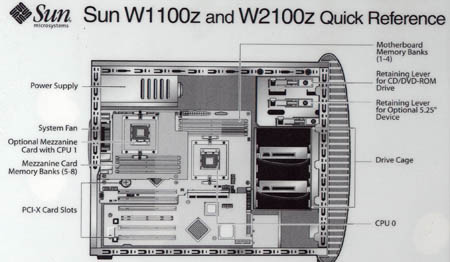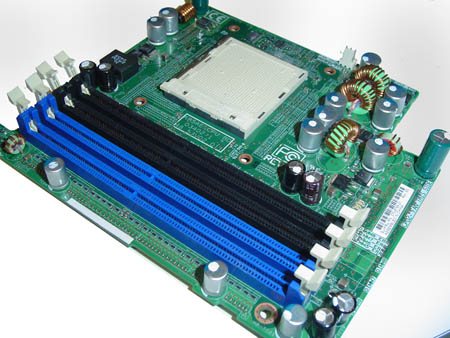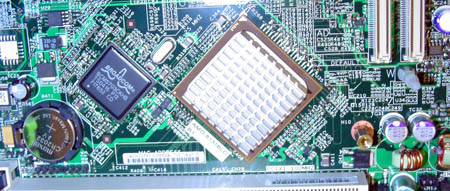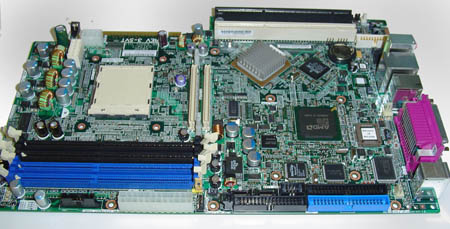Sun's W2100z Dual Opteron Workstation
by Kristopher Kubicki on October 27, 2004 12:05 AM EST- Posted in
- Systems
Components
The simplest way to detail the Sun w2100z is to just open it up and look at what Sun put under the hood. Our side panel on the workstation actually provides us with detailed knowledge of how the system works. You can see the side panel reference below.The core of the Sun w2100z is its K85AE motherboard. The K85AE is wildly different from anything to which we are accustomed, even when looking at server motherboards. Sun's modular approach to component design makes it a lot easier to upgrade (providing you use Sun components) and in turn, gives Sun customers a uniform base of components to pick and choose. Our particular w2100z came with all of the options, so we can detail them here.
| Sun K85AE Specifications | |
| CPU Type | (2) AMD Socket 940* |
| Memory Banks | (4) 1GB PC-3200 ECC DDR* |
| HyperTransport Tunnel | AMD 8111 |
| AGP Tunnel | None |
| PCI Tunnel | AMD 8131 |
| SATA | Silicon Image Sil3512 |
| PCI Slots | (1) 133MHz PCI-X (1) 100MHz PCI-X |
| SATA Ports | (2) U150 |
| PATA | (2) ATA100 |
| Audio | Realtek ALC655 AC'97 |
| Network | Broadcom BCM5703 Gigabit Ethernet |
| Firewire Ports | (2) |
| USB 2.0 Ports | (2) |
You'll notice the star next to the CPU type and Memory banks. The K85AE is a single CPU motherboard with a "CPU mezzanine" - two risers (one for power, one for IO) rise up through the center of the motherboard to provide four additional DDR banks and one additional CPU slot. Sun only needs to produce a single motherboard design and significant space inside the motherboard is saved. The idea of a CPU mezzanine is not new - particularly for Sun - but seeing such technology up close is always exciting. Below, you can see the CPU mezzanine removed from the system (a high resolution reverse side image can be found here.
There isn't anything too interesting about the mezzanine itself. Sun somewhat exploits the design of Opteron by placing the memory on the mezzanine with the CPU. Remember, all Athlon 64 and Opteron processors have their own memory controllers - each processor has its own memory bank. Technically, the primary Opteron on the motherboard can utilize the memory on the mezzanine via the HTCN bridge, although there is a performance hit by doing so.
The CPU mezzanine sits directly on top of the AMD 8111 HyperTransport hub and the first AMD 8131 PCI-X tunnel. Removing the mezzanine also reveals the Broadcom gigabit Ethernet controller, BIOS and SATA controller. You can read more about the SI controller here, and more about the Broadcom controller here. Both devices have fairly strong Linux support as we will see later in our analysis. The fact that our SATA controller only supports two drives is not of huge significance, since the chassis can only hold two drives anyway. Below is an image of both controllers once the CPU mezzanine is removed. The AMD 8131 is covered by an aluminum heatsink.
The entire board layout without the extender card can be seen below (those interested in a high resolution reverse side image can get that here:
The K85AE mainboard is far from legacy free. When we first unpackaged the workstation, we were surprised to not see any PS/2 interfaces (the included keyboard and mouse are USB). Under closer inspection, we noticed that PS/2 connectors did in fact exist, but they were covered by the EMI shield from the case. The motherboard houses two serial connectors and one parallel connector as well.
Also note the 133MHz PCI-X connector (black). The majority of peripheral components on the mainboard are very basic including the Realtek AC'97 audio controller. Sun seems very shy on USB, including only five devices (two of which must be used for the keyboard and mouse unless the PS/2 ports are revealed).














47 Comments
View All Comments
KristopherKubicki - Wednesday, October 27, 2004 - link
PrinceGaz: Multiple probes.Thanks for all the positive feedback!
Kristopher
slashbinslashbash - Wednesday, October 27, 2004 - link
#12, the Power Mac G5 is Apple's high-end workstation/server. The iMac is Apple's consumer-oriented product.I'd say that the PPC970 (G5) should be roughly comparable to an Opteron/Athlon64 at the same speeds -- at least much more comparable than a P4 at the same clock speeds. It's got a 16-stage integer pipeline, and the FPU units kick serious ass, especially with code that utilizes AltiVec (similar to SSE for x86). It's got a high-speed bus comparable to HyperTransport. AMD's integrated memory controller does give an advantage, but still I think the G5 could hang in there. Really though, any benchmark would come down to optimized code. Companies like Adobe and Apple that have the time, money, and inclination to optimize their applications for Apple hardware will see serious performance advantages over PC hardware. gcc-compiled apps, not so much, although more PPC-specific optimizations should come sooner or later.
Arstechnica has a very lengthy article on the PPC970 architecture. Take a look, if you have the time, and I don't think you'll walk away with a bad opinion of the G5.
BTW, I'm glad to see a Sun review here :) Interesting stuff. I would've liked to see another shot or two of the case itself, with all the components in it; plus a shot from the rear of the system. I'd like to see just how much space is in between that mezzanine card and the motherboard, and I'm kind of confused as to how the extender card fits in. It looks like it simply lies parallel with the motherboard (attaching along the bottom of the motherboard), but most of the time that there's a separate card, it is perpindicular.
thesix - Wednesday, October 27, 2004 - link
#12:"mlittl3 is attempting to compare a consumer product with a high end workstation/server."
You talk like a typical marketing person.
From pure HW design/layout point of view,
G5 _feels_ so much better than w2100z.
What makes me feel better with w2100z is the (new) Solairs OS and Opteron CPU.
Plus, I want to show support for both Sun and AMD :)
thesix - Wednesday, October 27, 2004 - link
I assume AMD CPUs/systems are faster. I haven't got a chance to do any serious testing between my dual-246 w2100z and my friend's dual-2.0GHz G5.I guess I simply don't care that much, anything less
than 10% of performance difference is not that significant to me. However, it's always good to know "my computer is faster than yours". :)
Reflex - Wednesday, October 27, 2004 - link
The problem with the recent Mac article appears to be that it has attracted the zealots to this site in force. mlittl3 is attempting to compare a consumer product with a high end workstation/server. They target different market segments and are designed for different tasks. Furthermore, the support offered for each, and the type of support is considerably different. Its Apples to Oranges.#11: We'll never really know how fast a G5 is in comparison, Apple does not allow independant hardware reviews, leaving it up to websites to purchase and test their own hardware. I know of no site as comprehensive as Anandtech on the Mac side of things as a result, so any claims of G5 performance are pretty much guesstimates and marketing unfortunatly. I wish this would change, it would be nice to know how Apple hardware really does perform as that would assist network admins in determining where it fits/if it fits into their current setup. Just being told by a company that "Its fast and stable" is not enough to make a corporation invest in a platform.
PrinceGaz - Wednesday, October 27, 2004 - link
Great review, the thermal graph is especially good in showing how the cooling performs. Did you attach many probes and take all the measurements in one go, or have to do it multiple times?----
The dual G5 uses some sort of liquid-cooling system inside the case I believe. That probably helps it reduce the noise.
Is a dual 2.5GHz G5 machine as fast as a dual Opteron 250 (2.4GHz) box anyway? Results posted by Apple themselves don't count of course :)
fic - Wednesday, October 27, 2004 - link
#8 you could replace the FX3000 with a 6800 and save another $1000.I would like to see a comparison between the w2100z and 2nd tier companies like Boxx, XI, Aspen, etc. I have been trying to talk my company into moving to a 2x 250 system from a 2x Xeon system to ship with our product. BTW, we do digital medical imaging and need the processing power to do image processing on our 4096x5625 images.
thesix - Wednesday, October 27, 2004 - link
I am surprised to see w2100z is rated as _quiet_ here. I _personally own_ w2100z for almost 3 months now, at home. Apple G5 is _much_ quieter than w2100z. In fact, noise is my biggest complain about w2100z, and I spent lots of time trying to "fix" it. I am confused.http://www.pbase.com/taochen/w2100z
mlittl3 - Wednesday, October 27, 2004 - link
Well, I guess all you apple-haters' comments that x86 computers are cheaper than apple computers can eat your words.Whitebox system $5284
Sun w23100z $8695
Apple Dual G5 2.5 GHz $5570
(configed with 4 GB RAM, larger 160 GB harddrive, Geforce 6800 which spanks the FX3000's ass and combo drive)
Oh that's right, you guys think the dual G5 system was meant for your grandmother to check email and your baby brother to play spongebob squarepants video games.
Get a clue. Good x86 systems with dual processors from reputable companies like Sun (or even whitebox systems) and dual apple systems cost about the same. Let's end at least the price part of apple vs x86 right here and now.
Araemo - Wednesday, October 27, 2004 - link
Wow.. you guys outdid yourselves, especially with the thermal graphs. I also want to say how nice it is to have a couple new reviews every week again. Keep up the good work guys. :)